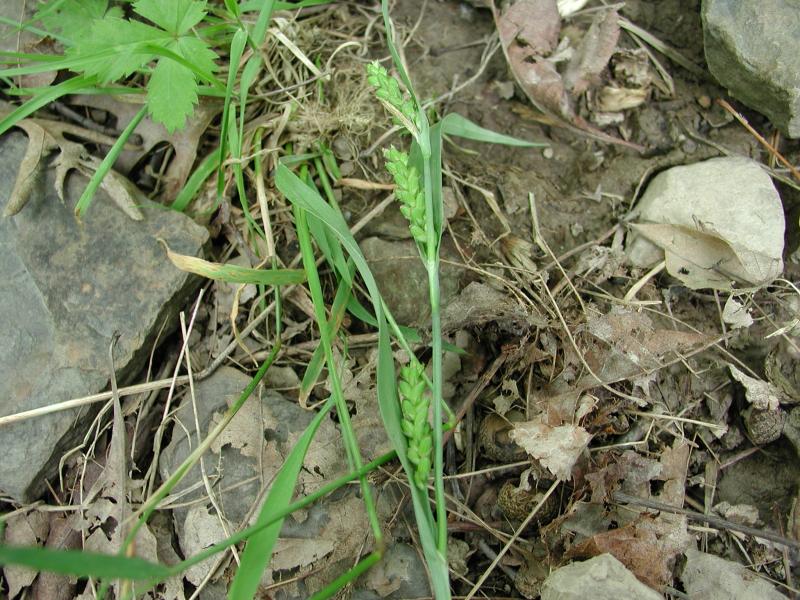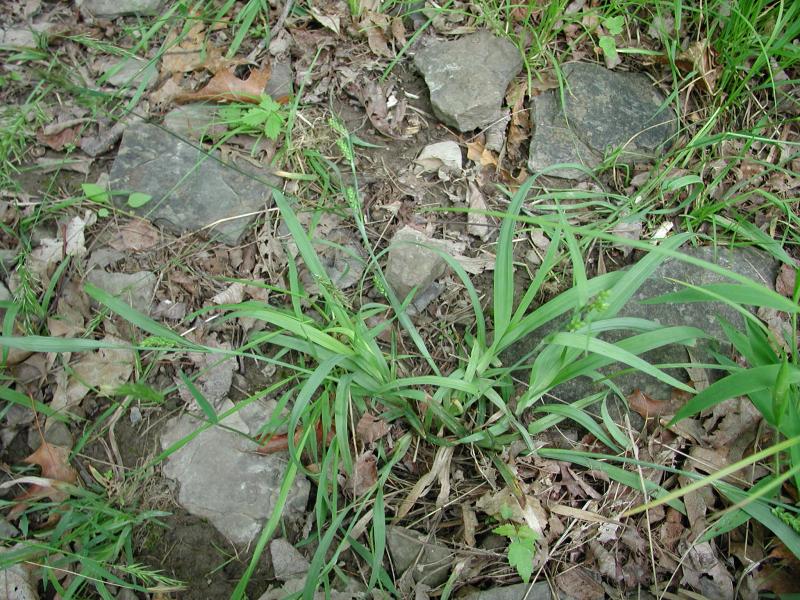Glaucous Sedge
Carex glaucodea Tuckerman ex Olney
- Class
- Monocotyledoneae (Monocots)
- Family
- Cyperaceae (Sedge Family)
- State Protection
- Threatened
Listed as Threatened by New York State: likely to become Endangered in the foreseeable future. For animals, taking, importation, transportation, or possession is prohibited, except under license or permit. For plants, removal or damage without the consent of the landowner is prohibited.
- Federal Protection
- Not Listed
- State Conservation Status Rank
- S2
Imperiled in New York - Very vulnerable to disappearing from New York due to rarity or other factors; typically 6 to 20 populations or locations in New York, very few individuals, very restricted range, few remaining acres (or miles of stream), and/or steep declines.
- Global Conservation Status Rank
- G5T5
Secure globally - Both the species as a whole and the subspecies/variety are common in the world; widespread and abundant (but may be rare in some parts of its range).
Summary
Did you know?
Glaucodea means gray-green (Fernald 1970), which is the color of the leaves and is created by a thin waxy coating on the surface of the leaf blades.
State Ranking Justification
There are six existing populations but more are expected to be found as more people become familiar with the identification of this species. There are 10 historical occurrences.
Short-term Trends
In the past five years at least five new populations have been found. Most likely these populations have been overlooked in the past. Ten populations are considered historical because they have not been seen in recent years but again this may simply be due to the fact that they have been overlooked recently. Overall short-term trends are not clear.
Long-term Trends
There is one extant population that has been known for over 120 years. This population is quite healthy and robust. At least two populations are believed to be extirpated. Other information regarding long term trends is not available.
Conservation and Management
Threats
None known.
Conservation Strategies and Management Practices
No management needs known.
Habitat
Habitat
Carex glaucodea occurs in wet to dry-mesic deciduous forests and old fields. It occurs on the edges of seasonal swamps and in seasonally wet depressions in more open environments. Plants can often be found in roads and deer or human paths through forests. These roads and paths probably are helping the seed bank germinate. Also, these roads and paths often have more compacted soils creating slightly wetter situations preferred by C. glaucodea (New York Natural Heritage Program 2005). Mesic to wet-mesic deciduous forests or seasonally moist prairies, usually in clays or loams (Naczi and Bryson 2002). Dry to moist calcareous woods or fields (Rhoads and Block 2000). Wet woods, swamps, moist fields (Gleason & Cronquist 1991). Calcareous woods and meadows (Fernald 1970).
Associated Ecological Communities
- Appalachian oak-hickory forest
(guide)
A hardwood forest that occurs on well-drained sites, usually on ridgetops, upper slopes, or south- and west-facing slopes. The soils are usually loams or sandy loams. This is a broadly defined forest community with several regional and edaphic variants. The dominant trees include red oak, white oak, and/or black oak. Mixed with the oaks, usually at lower densities, are pignut, shagbark, and/or sweet pignut hickory.
- Chestnut oak forest
(guide)
A hardwood forest that occurs on well-drained sites in glaciated portions of the Appalachians, and on the coastal plain. This forest is similar to the Allegheny oak forest; it is distinguished by fewer canopy dominants and a less diverse shrublayer and groundlayer flora. Dominant trees are typically chestnut oak and red oak.
- Perched swamp white oak swamp
(guide)
A swamp that occurs in a shallow depression on a forested hillside where the water table is locally perched above the surrounding groundwater level. The water level fluctuates seasonally; the swamp may be flooded in spring and nearly dry by late summer. The dominant tree is swamp white oak, which may form a nearly pure, open canopy stand in areas that are permanently saturated.
- Successional old field
A meadow dominated by forbs and grasses that occurs on sites that have been cleared and plowed (for farming or development), and then abandoned or only occasionally mowed.
- Successional southern hardwoods
A hardwood or mixed forest that occurs on sites that have been cleared or otherwise disturbed. Canopy trees are usually relatively young in age (25-50 years old) and signs of earlier forest disturbance are often evident. Characteristic trees and shrubs include any of the following: American elm, slippery elm, white ash, red maple, box elder, silver maple, sassafras, gray birch, hawthorn, eastern red cedar, and choke-cherry.
Associated Species
- Acer rubrum var. rubrum (common red maple)
- Carex bushii (Bush's sedge)
- Carex nigromarginata (black-edged sedge)
- Carya glabra (pignut hickory)
- Cuscuta sp.
- Danthonia spicata (poverty grass)
- Fraxinus americana (white ash)
- Hamamelis virginiana (witch-hazel)
- Hypoxis hirsuta (yellow star-grass)
- Juncus tenuis (path rush)
- Lobelia inflata (Indian tobacco)
- Lyonia ligustrina
- Microstegium vimineum (Japanese stilt grass)
- Ostrya virginiana (hop hornbeam, ironwood)
- Pinus rigida (pitch pine)
- Pinus strobus (white pine)
- Polygonum spp.
- Prunus pumila var. susquehanae
- Quercus alba (white oak)
- Quercus coccinea (scarlet oak)
- Quercus palustris (pin oak)
- Quercus rubra (northern red oak)
- Saururus cernuus (lizard's-tail)
Range
New York State Distribution
Carex glaucodea is known mostly from eastern New York (Albany and Rensselaer Counties south to Long Island) but is also known from a couple of sites in central New York.
Global Distribution
This sedge occurs from New Hampshire, Massachusetts, and Connecticut west to New York, Ontario, Ohio, and Missouri south to North Carolina, Tennessee, Alabama, Oklahoma, and Texas.
Identification Comments
General Description
This sedge is a densely tufted grass-like plant with leaves covered with a white waxy covering (glaucous) and up to (5.1-)5.7-10.8 mm wide. Flowering/fruiting stalks (culms) are 10-50 cm tall and contain 3-6 elongated clusters of flowers/fruits (spikes) that are arranged along the culm. Fruits (perigynia) have many fine impressed longitudinal nerves (Naczi and Bryson 2002).
Identifying Characteristics
Carex glaucodea has glaucous leaves. The bases of the culms are yellow-brown. The inflorescence consists of one terminal staminate spike which is 7-35 mm long and 2-5 lateral pistillate spikes. The peduncles of the pistillate spikes are smooth. Perigynia are spirally arranged along the axis of the spike, 3.2-4(-4.1) mm long, gradually taper to the apex, have no or only a tiny (0-0.3 mm long) beak, and have 43-54 impressed longitudinal nerves. Pistillate scales are relatively short awned tipped with awns 0-1(-1.5) mm long. Achenes have beaks that are bent (0-)30-90 degrees (Naczi and Bryson 2002).
Best Life Stage for Proper Identification
The glaucous leaves make this Carex a little easier to identify vegetatively although fruits are still necessary to make a positive identification. Mature ample specimens with notes on whether the leaves are glaucous or not are best for identification.
Similar Species
In New York, this species is quite distinctive. There are two other Carex species (C. granularis and C. laxiculmis var. laxiculmis) which look similar vegetatively. Carex granularis has smaller perigynia (2.2-3.1(-3.7) mm long vs. to 3.2-4(-4.1) for C. glaucodea); "nerves" of the perigynia raised (vs. impressed); and beaks of the perigynia, when present, sometimes bent (vs. never bent). Carex laxiculmis has pistillate peduncles flexuous and drooping (vs. stiffer and erect to ascending); 4-9 perigynia per spike (vs. 10-45); and sharply triangular perigynia in cross section (vs. obtusely triangular) (Yatskievych 1999, Naczi and Bryson 2002).
Other members of section Griseae in New York, which C. glaucodea is part of, have green leaves (vs. glaucous) and pistillate scales with longer awns (vs. short or no awns). Awns can occasionally be variable in length. Carex glaucodea is the only member of section Griseae that will appear highly glaucous.
Best Time to See
The species is in fruit from June to mid-July. Fruits can sometimes be found on plants later in the season. The best time to survey for this species is mid-June to mid-July.
- Fruiting
The time of year you would expect to find Glaucous Sedge fruiting in New York.
Glaucous Sedge Images
Taxonomy
Glaucous Sedge
Carex glaucodea Tuckerman ex Olney
- Kingdom Plantae
- Phylum Anthophyta
- Class Monocotyledoneae
(Monocots)
- Order Cyperales
- Family Cyperaceae (Sedge Family)
- Order Cyperales
- Class Monocotyledoneae
(Monocots)
- Phylum Anthophyta
Additional Common Names
- Sedge
Synonyms
- Carex flaccosperma var. glaucodea (Tuckerman ex Olney) Kukenth.
Comments on the Classification
Carex glaucodea along with C. flaccosperma have been variously treated by many authors. Some authors treat C. glaucodea as a variety of C. flaccosperma (e.g. Fernald 1970), others lump the two together (e.g. Gleason and Cronquist 1991), and others treat the two at the species level. Naczi (1991) shows that the two should be considered distinct at the species level based on morphology, cytology, ecology, geography, and natural hybridization. In addition, Naczi (1997) described a new species C. pigra which is intermediate in perigynia length between C. glaucodea and C. flaccosperma. This may have been part of the reason why some botanists were confused regarding the status of C. glaucodea and C. flaccosperma. In New York, we only have one taxon, C. glaucodea. Carex pigra and C. flaccosperma occur further south and west of New York.
Additional Resources
Best Identification Reference
Naczi, R.F.C. and C.T. Bryson. 2002. Carex Linnaeus sect. Griseae (L.H. Bailey) Kükenthal. Pages 448-461 in Flora of North America Editorial Committee (editors), Flora of North America, north of Mexico, Volume 23, Magnoliophyta: Commelinidae (in part): Cyperaceae. Oxford University Press, New York, NY, USA. 608pp + xxiv.
Other References
Fernald, M.L. 1950. Gray's manual of botany. 8th edition. D. Van Nostrand, New York. 1632 pp.
Flora of North America Editorial Committee. 2002. Flora of North America, North of Mexico. Volume 23. Magnoliophyta: Commelinidae (in part): Cyperaceae. Oxford University Press, New York. 608 pp.
Gleason, Henry A. and A. Cronquist. 1991. Manual of Vascular Plants of Northeastern United States and Adjacent Canada. The New York Botanical Garden, Bronx, New York. 910 pp.
Holmgren, Noel. 1998. The Illustrated Companion to Gleason and Cronquist's Manual. Illustrations of the Vascular Plants of Northeastern United States and Adjacent Canada. The New York Botanical Garden, Bronx, New York.
Mitchell, Richard S. and Gordon C. Tucker. 1997. Revised Checklist of New York State Plants. Contributions to a Flora of New York State. Checklist IV. Bulletin No. 490. New York State Museum. Albany, NY. 400 pp.
Naczi, R.F.C. 1991. Systematics of Carex flaccosperma and C. glaucodea (section Griseae, Cyperaceae). Supplement to American Journal of Botany 78: 205.
New York Natural Heritage Program. 2010. Biotics database. New York Natural Heritage Program. New York State Department of Environmental Conservation. Albany, NY.
New York Natural Heritage Program. 2024. New York Natural Heritage Program Databases. Albany, NY.
Reschke, Carol. 1990. Ecological communities of New York State. New York Natural Heritage Program, New York State Department of Environmental Conservation. Latham, NY. 96 pp. plus xi.
Rhoads, Ann F. and Timothy A. Block. 2000. The Plants of Pennsylvania, an Illustrated Manual. University of Pennsylvania Press, Philadelphia, PA.
Weldy, T. and D. Werier. 2010. New York flora atlas. [S.M. Landry, K.N. Campbell, and L.D. Mabe (original application development), Florida Center for Community Design and Research http://www.fccdr.usf.edu/. University of South Florida http://www.usf.edu/]. New York Flora Association http://newyork.plantatlas.usf.edu/, Albany, New York
Yatskievych, G. 1999. Steyermark's Flora of Missouri, Volume 1. Revised edition. Missouri Department of Conservation, Jefferson City and Missouri Botanical Garden Press, St. Louis.
Links
About This Guide
Information for this guide was last updated on: June 22, 2005
Please cite this page as:
New York Natural Heritage Program. 2024.
Online Conservation Guide for
Carex glaucodea.
Available from: https://guides.nynhp.org/glaucous-sedge/.
Accessed July 27, 2024.

